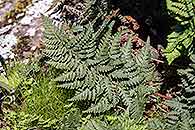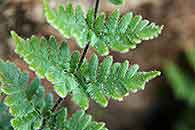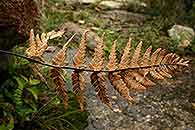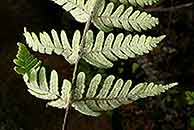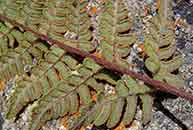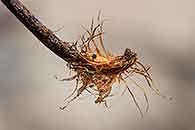Cheilanthes inaequalis (Kunze) Mett.
Synonyms |
Notholaena inaequalis Kunze |
|---|---|
Common name |
|
Description |
Rhizome shortly creeping to suberect, c. 5 mm in diameter; rhizome scales narrowly lanceolate to linear in outline, margin entire, up to 2 cm long, rust-coloured. Fronds monomorphic, tufted, erect, herbaceous to coriaceous, shriveling up during the dry winter months. Stipe 2.5-20 cm long, purple-dark brown to black, with short, fine white hairs and with scales similar to those of the rhizome at the base. Lamina deeply 2-pinnatifid to 3-pinnatifid on the basal pinnae which are not reduced in size, ovate to lanceolate or triangular-elliptic in outline, up to 22 cm × 11 cm; pinnae in 11-14 pairs, lanceolate in outline, margins entire to lobed, 1.5-3.5 x 1 cm, upper surface sparsely set with stiff hairs, lower surface densely covered with short white hairs, turning reddish-brown with age; venation obscure; rhachis dark brown. Sori marginal, discrete at first but continuous when mature; indusium continuous or discontinuous, narrow, ciliate, membranous. |
Notes | Could be confused with C. eckloniana which has shiny golden-brown scales along the costae and costules, and basal pinnae that might be slightly reduced. The lower surface of the lamina of C. buchananii is only sparsely covered with long, whitish hairs. |
Derivation | inaequalis: unequal; referring to the unaequal structure of the basal pinnae. |
Habitat | Cracks and crevices and in the shelter of boulders on granite sheetrock, in full sun or bases of rocks in woodland or grassland. |
Distribution worldwide | Africa, Madagascar. |
Distribution in Africa |
Angola, Burundi, Cameroon, Dem. Republic of Congo, Ethiopia, Guinea, Kenya, Liberia, Malawi, Mozambique, Namibia, Nigeria, Rwanda, South Africa, Sudan and South Sudan, Tanzania , Uganda, Zambia, Zimbabwe. |
Growth form |
Lithophytic, terrestrial. |
Literature |
|



